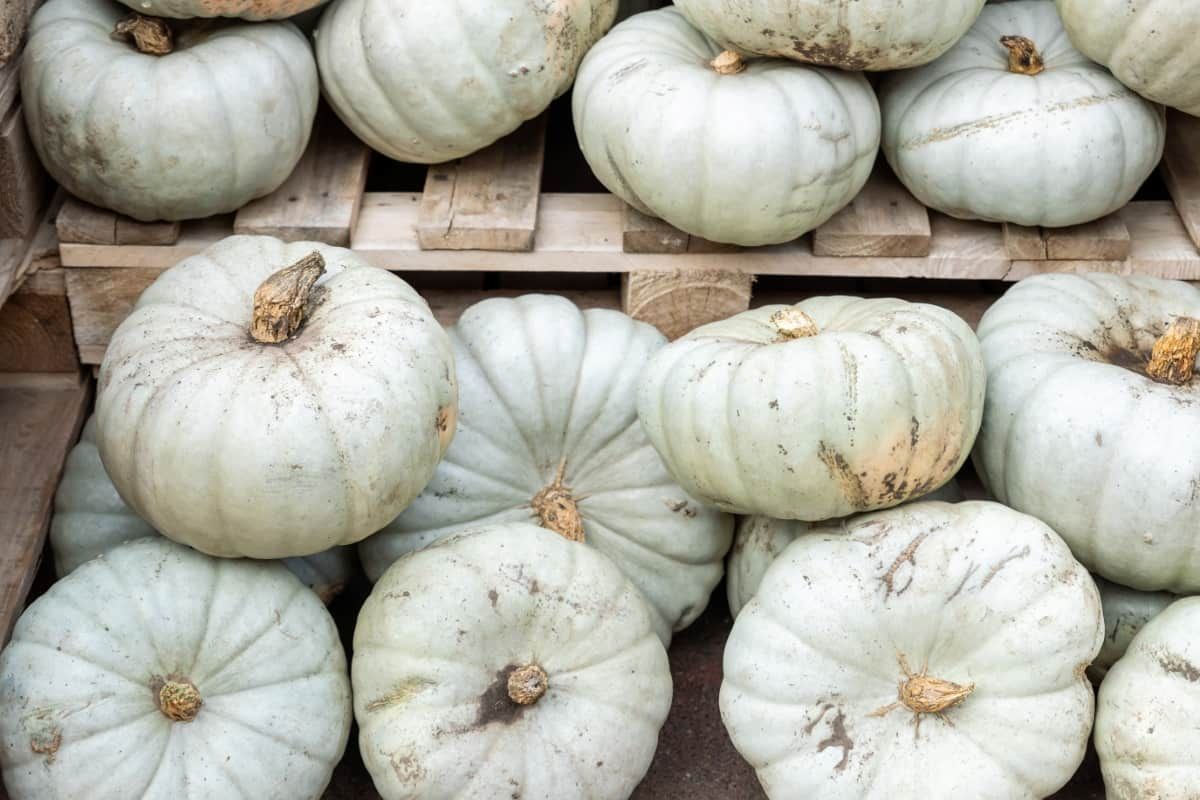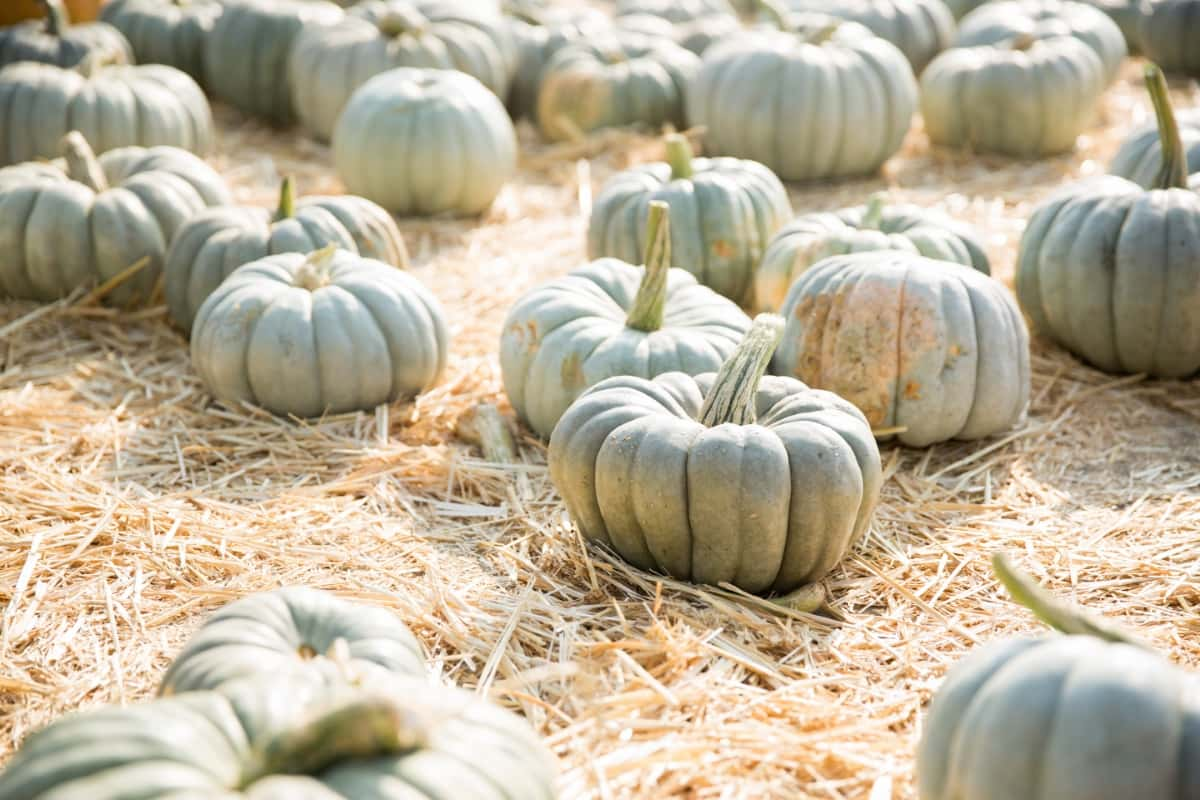When it comes to growing Jarrahdale pumpkins, the question often arises: How do you grow Jarrahdale pumpkins? The allure of the Jarrahdale pumpkin doesn’t just lie in its unique bluish-gray color and deeply ribbed skin; it’s also about the nutty, sweet taste and the myriad uses in culinary and ornamental contexts. How long do Jarrahdale pumpkins take to grow?

This question, along with details about its size, weight, price, and benefits, all come together to tell the comprehensive history of this fascinating gourd. If you’re interested in everything about Jarrahdale pumpkins, from the history of the Jarrahdale pumpkin to its uses, benefits, and even where to buy Jarrahdale pumpkins, this guide will serve as your one-stop resource.
How to Grow Jarrahdale Pumpkin from Seed
Growing Jarrahdale pumpkins begins with the right seed, soil, and conditions. You can plant seeds in the garden once frost isn’t a threat or begin indoors 2-4 weeks before moving them outside. Choose good soil with organic material and aim for a pH level between 6.0 and 7.0 for the best outcome. Plant seeds about an inch deep and give them plenty of space to grow, about 2-3 feet between plants in rows 6-8 feet apart. Watering is key, especially in dry spells; moisten the soil but avoid waterlogged conditions.
As for fertilization, a balanced fertilizer applied during the growing season can enhance growth. How do you grow Jarrahdale pumpkins to their full potential? Pay close attention to common pests like squash bugs, and preventative measures like crop rotation can help maintain plant health. How long do Jarrahdale pumpkins take to grow? Typically, they take about 90-100 days to reach maturity after the seed germinates.
Uses of Jarrahdale Pumpkin
Jarrahdale pumpkins are multifaceted marvels, seamlessly transitioning from eye-catching yard decorations to kitchen superstars. They make excellent carving pumpkins because of their firm flesh and symmetrical form, but the real magic lies in their culinary versatility. The sweet, somewhat nutty flesh is fantastic in pies, soups, muffins, and even pumpkin puree.
Don’t forget the seeds; they can be roasted for a crunchy, nutritious snack. Beyond the kitchen, the Jarrahdale’s unique blue-gray color and decorative ribs make it a popular choice for fall decorations and Halloween festivities. Additionally, they have a long shelf life, making them ideal for extended display or storage.
Benefits of Consuming Jarrahdale Pumpkin
Adding Jarrahdale pumpkin to your diet can provide various health benefits. It gives you lots of Vitamin A that’s important for your eyes, skin, and immunity. With plenty of fiber, it helps digestion and can assist with weight control by making you feel full. Moreover, the pumpkin’s seeds are laden with magnesium, essential for bone health, and contain antioxidants like Vitamin E.
In case you missed it: All About Cinderella Pumpkin: Varieties, History, Size, Planting, Growing, and Care

A key benefit of consuming Jarrahdale pumpkins is their low-calorie count, making them a weight-friendly addition to meals. The high water content also helps in hydration, and its low glycemic index makes it suitable for those monitoring blood sugar levels.
Size and Weight of Jarrahdale Pumpkin
Usually, their size is about 10 to 12 inches across, and they can weigh from 6 to 12 pounds. Their size makes them manageable for various uses, from carving and decoration to culinary applications. Though not the largest in the pumpkin family, their deep ribs and consistent shape give them a substantial presence. As they grow, it’s essential to provide ample space in the garden to allow them to reach their full size and weight potential, a key aspect to consider in growing Jarrahdale pumpkins.
Price Range for Jarrahdale Pumpkin
Given its unique color and multifunctional uses, the Jarrahdale pumpkin tends to be more expensive than your average orange pumpkin. The cost of pumpkins can change depending on where you are, the time of year, and if they’re available. Usually, they cost around $10 to $20 each. Sometimes, specialized or organic farms may charge even more.
Though the initial cost may seem steep, considering the range of uses from decorative to culinary, many find the price well justified. When purchased for planting, the seeds themselves can also be pricier than other varieties but are usually affordable and available in multiple gardening stores.
Origin of Jarrahdale Pumpkin
The history of the Jarrahdale pumpkin dates back to New Zealand, where it was first cultivated. It’s a cross between the Cinderella pumpkin and the Blue Hubbard squash, resulting in its distinct blue-gray skin. It’s especially popular in the United States, often a staple in fall decorations and holiday recipes. Its unique color and texture have made it a popular choice for breeders and gardeners looking for something that stands out from the more common orange varieties.
Jarrahdale Pumpkin Taste
The taste of a Jarrahdale pumpkin is one of its standout qualities. Its firm, orange flesh is sweet and nutty, with a hint of fruity undertones. It has a smoother texture compared to other pumpkin varieties, which makes it ideal for pies and purees. This delectable taste profile has made it a sought-after choice for various recipes, including soups and baked goods. Suppose you’re looking for a pumpkin that provides a unique flavor, different from the usual sweetness of butternut squash but not as intense as a kabocha. In that case, the Jarrahdale is an excellent choice.
Where to Buy Jarrahdale Pumpkins
If you’re interested in where to buy Jarrahdale pumpkins, several options are available. They are commonly found at local farmer’s markets, specialty grocery stores, and garden centers during fall. Online platforms also offer seeds for those interested in growing Jarrahdale pumpkins. As with any produce, purchasing from a local or trusted source ensures you get the best quality and most flavorful pumpkins.
History and Cultural Significance of Jarrahdale Pumpkin
Originating in New Zealand, the Jarrahdale pumpkin is a hybrid between the Cinderella pumpkin and the Blue Hubbard squash. Its striking blue-gray hue and ribbed exterior have made it a culturally significant symbol of autumn in many countries, including the United States. Whether gracing front porches as decor or starring in seasonal dishes, this unique pumpkin variety is cherished in culinary and ornamental spheres.
In case you missed it: How to Grow Atlantic Giant Pumpkin from Seeds: Planting, Size, and Weight

Nutritional Value and Health Benefits of Jarrahdale Pumpkin
Jarrahdale pumpkins offer a nutritional punch with their rich content of Vitamin A, fiber, and antioxidants. The orange flesh is excellent for vision, skin health, and immune system boosting. Furthermore, the seeds contain magnesium, which helps keep bones healthy. With a low glycemic index and high water content, Jarrahdale pumpkins are suitable for weight management and provide hydration benefits.
Comparison of Jarrahdale Pumpkin with Other Pumpkin Varieties
Compared to classic orange pumpkins, Jarrahdales stand out for their unique blue-gray skin and deeply ribbed surface. In terms of taste, their sweet and nutty flavor with a hint of fruitiness offers a different experience from the straightforward sweetness of most other varieties. Size-wise, Jarrahdale pumpkins are medium, weighing between 6 to 12 pounds, making them versatile for various uses, from carving to cooking, without overly cumbersome.
Conclusion
The Jarrahdale pumpkin is a remarkable gourd with a unique history, numerous health benefits, and notable distinctions from other pumpkin varieties.
- Feed Your Flock for Less: Top 10 Tips to Save on Chicken Feed
- Ultimate Guide to Ossabaw Island Hog: Breeding, Raising, Diet, and Care
- Hatching Answers: The Top 10 Reasons Your Chickens Aren’t Laying Eggs
- Eggs and Economics: Breaking Down the Cost of Raising Backyard Chickens
- Defend Your Greens: Proven Methods to Keep Iguanas Out of Your Garden
- Ultimate Guide to Cinnamon Queen Chicken: A Comprehensive Guide for Beginners
- Ultimate Guide to California Tan Chicken: Breeding, Raising, Diet, Egg-Production and Care
- Ultimate Guide to Marsh Daisy Chicken: Breeding, Raising, Diet, and Care
- 10 Types of Chicken Farming Businesses You Can Start for Profits